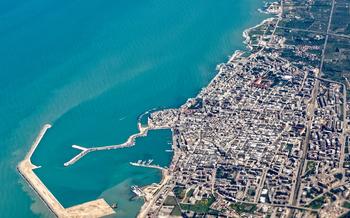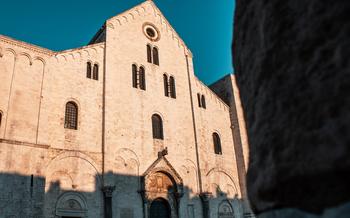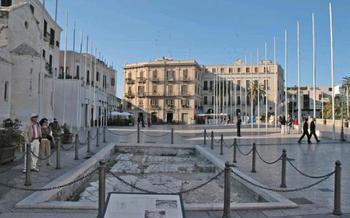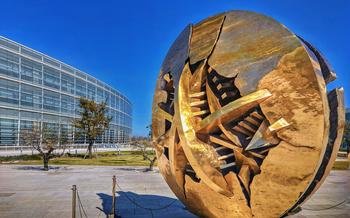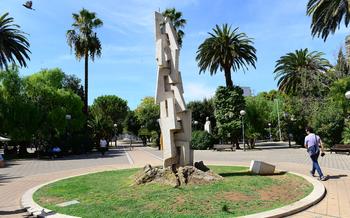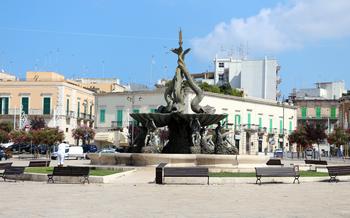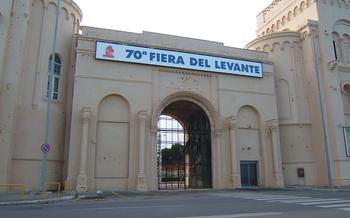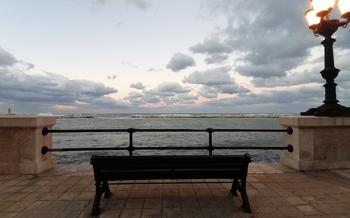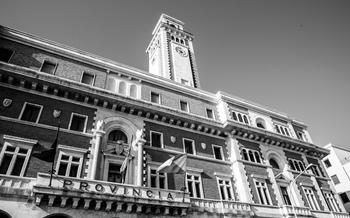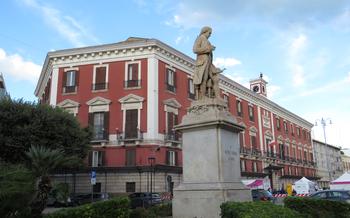
Cattedrale di San Sabino
- Introduction
- Exploring the Exterior
- Stepping Inside
- Crypt of Saint Sabinus
- Altar of Saint Sabinus
- Transepts and Chapels
- Organ and Pulpit
- Basilica Status
- Guided Tours
- Pilgrimage Destination
- Feast of Saint Sabinus: A Grand Celebration
- Legends and Myths
- Restoration Efforts: Preserving a Legacy of Faith and Splendor
- Visiting Information
- Insider Tip: Unveiling the Secrets of Bari's Cathedrals
Introduction
In the heart of Puglia, Italy, lies the captivating city of Bari, a vibrant tapestry of history, culture, and religious devotion. Among its many architectural wonders, the Cattedrale di San Sabino stands as a testament to the city's spiritual and artistic heritage. This magnificent 12th-century cathedral is dedicated to Saint Sabinus, the patron saint of Bari, and holds a profound significance for both the city and the region.
The cathedral's origins can be traced back to the 11th century when Bari was a thriving maritime republic. The construction of the cathedral began in 1087 under the patronage of Archbishop Rainaldo, and it was completed around 1170. The architectural style of the cathedral is primarily Romanesque, characterized by its sturdy construction, rounded arches, and intricate carvings. The cathedral's facade is adorned with a series of finely sculpted panels depicting biblical scenes and figures, while its interior features a vast nave, stunning stained glass windows, and ornate ceiling frescoes.
Exploring the Exterior
The Cattedrale di San Sabino's exterior is a captivating blend of architectural styles and intricate details. The imposing facade, adorned with delicate carvings and sculptures, showcases the transition from Romanesque to Gothic influences. The central portal, with its intricate bas-reliefs depicting biblical scenes, invites visitors into the sacred space within.
The cathedral's most striking feature is its unique bell tower, affectionately known as the "Torre delle Campane." Rising high above the city skyline, the tower comprises five distinct tiers, each adorned with intricate carvings and decorative elements. The octagonal lantern crowning the tower offers breathtaking panoramic views of Bari and the surrounding countryside, making it a must-visit destination for adventurous travelers.
Symbolism abounds in the cathedral's exterior sculptures, each carefully crafted to convey a profound message. Gargoyles and mythical creatures adorn the corners of the building, serving as guardians against evil spirits. The intricate carvings on the capitals of the columns narrate biblical stories and the lives of saints, providing a visual feast for visitors.
Stepping Inside
As you cross the threshold of the Cattedrale di San Sabino, a sense of awe and reverence washes over you. The vast dimensions of the interior are immediately apparent, with towering columns supporting grand arches that soar towards the heavens. The walls are adorned with intricate frescoes, depicting biblical scenes and stories of saints, their vibrant colors still retaining their brilliance despite the passage of time.
Sunlight filters through the stunning stained glass windows, casting a kaleidoscope of hues onto the marble floor below. Each window tells a story, portraying events from the life of Saint Sabinus, the patron saint of Bari, and other religious figures. The intricate details of the stained glass are a testament to the skill and artistry of the craftsmen who created them centuries ago.
The ceiling frescoes are equally impressive, covering the entire expanse of the vaulted ceiling with breathtaking scenes from the Bible. The stories of creation, the prophets, and the life of Jesus Christ are depicted in vivid detail, each brushstroke contributing to the overall narrative of faith and devotion.
Crypt of Saint Sabinus
Concealed beneath the grand floor of the cathedral lies a hallowed sanctuary—the Crypt of Saint Sabinus. This subterranean realm unfolds an otherworldly dimension of history and reverence. In the 11th century, as the cathedral's construction neared completion, workers stumbled upon an extraordinary discovery: the relics of Saint Sabinus, the city's patron saint. This serendipitous event transformed the crypt into a sacred repository, drawing pilgrims from far and wide to pay homage to the saint's remains.
Descending into the crypt is akin to stepping into a time capsule, where the echoes of devotion reverberate through the centuries. The air is pregnant with a tangible sense of history, inviting visitors to delve into the cathedral's profound spiritual legacy. Intricate mosaics, preserved with remarkable care, adorn the walls and ceilings, narrating stories from the Bible and the life of Saint Sabinus. The flickering candlelight casts an ethereal glow upon these vibrant depictions, creating a mesmerizing spectacle.
The atmosphere within the crypt is palpably sacred, yet suffused with an eerie serenity. It is a sanctuary where the faithful can commune with Saint Sabinus, seeking solace, guidance, and spiritual renewal. Pilgrims often pay their respects at the saint's tomb, which is adorned with intricate carvings and exudes an aura of sanctity. The crypt's hallowed ambiance invites contemplation and introspection, fostering a deep connection between visitors and the divine.
Altar of Saint Sabinus
The Altar of Saint Sabinus, located within the heart of the cathedral, holds immense historical significance. Constructed in the 11th century, this awe-inspiring altar serves as a testament to the enduring devotion to the city's patron saint. Its intricate carvings and opulent adornments reflect the deep reverence held by the local community.
Beyond its historical importance, the altar possesses several distinctive features that captivate visitors. The central focus of the altar is a striking silver reliquary, believed to contain fragments of Saint Sabinus' remains. This sacred relic draws pilgrims from far and wide, who come to pay homage to the saint and seek his intercession.
The altar's design exudes an aura of grandeur, with its elaborate canopy supported by four majestic columns. The canopy is adorned with intricate carvings depicting scenes from the life of Saint Sabinus, further enhancing the altar's spiritual significance.
Local traditions and devotion surrounding the Altar of Saint Sabinus are deeply embedded in the cultural fabric of Bari. Every year, on the feast day of Saint Sabinus, a solemn procession carries the saint's relics through the city streets, culminating at the altar within the cathedral. This procession is a spectacle of faith and devotion, drawing thousands of participants who come to honor their patron saint and seek his blessings.
Transepts and Chapels
Exploring the transepts and chapels within the Cattedrale di San Sabino reveals a treasure trove of artistic masterpieces and historical significance. In the north transept, visitors can admire the intricate carvings of the Altar of the Crucifixion, a captivating work of art depicting the crucifixion of Jesus Christ. The south transept, on the other hand, houses the Altar of the Assumption, adorned with a breathtaking depiction of the Virgin Mary's ascent into heaven.
Among the notable chapels within the cathedral, the Cappella di San Nicola stands out with its stunning frescoes portraying scenes from the life of Saint Nicholas. The Cappella del Santissimo Sacramento, dedicated to the Holy Sacrament, captivates visitors with its intricate carvings and delicate stained glass windows. Each chapel tells a unique story through its artwork, altars, and historical significance, providing an immersive journey into the spiritual and cultural heritage of Bari.
Organ and Pulpit
The grandeur of the Cattedrale di San Sabino is further enhanced by its majestic organ and intricately carved pulpit. The organ, a masterpiece of craftsmanship, dominates the interior with its imposing presence. Its ornate pipes, arranged in intricate patterns, create a symphony of sound that reverberates through the vast space, filling it with heavenly melodies.
The pulpit, a testament to the artistry of the cathedral's builders, stands as a symbol of eloquence and authority. Crafted from rich, dark wood, it is adorned with intricate carvings depicting biblical scenes and allegorical figures. The pulpit's intricate reliefs, showcasing the skill and devotion of the artisans, invite visitors to contemplate the profound messages they convey.
These masterpieces, both functional and symbolic, contribute to the cathedral's spiritual ambiance. The organ's celestial music elevates the hearts and minds of the faithful, while the pulpit serves as a platform for delivering divine messages and inspiring contemplation. Together, they create a harmonious blend of art and devotion that enriches the visitor's experience.
Basilica Status
The elevation of the Cattedrale di San Sabino to the marked a significant milestone in its history. This prestigious designation is bestowed upon churches that hold special religious and historical importance, and the criteria are stringent. The cathedral's architectural grandeur, artistic treasures, and enduring spiritual significance made it a worthy candidate for this honor.
The basilica status brought with it not only recognition but also enhanced spiritual significance. Pilgrims and visitors from around the world can now experience a heightened sense of reverence and devotion within its sacred walls. The designation serves as a testament to the enduring legacy of the cathedral and its role as a beacon of faith for generations.
Guided Tours
Enhance your visit to the Cattedrale di San Sabino by embarking on a guided tour, a journey that will unveil the cathedral's captivating history, art, and religious significance. Led by knowledgeable guides, these tours provide an insider's perspective, allowing visitors to delve deeper into the stories behind the stones.
Guided tours are available throughout the day, ensuring that visitors can find a time that suits their schedule. Reservations are recommended, especially for groups, to secure a spot and avoid any disappointment.
Themes and itineraries vary, catering to diverse interests. Some focus on the cathedral's architectural evolution, highlighting the unique blend of Romanesque and Gothic styles. Others delve into the lives of the saints and martyrs associated with the cathedral, shedding light on their contributions to the city's spiritual heritage.
Whether you're a history buff, an art enthusiast, or a pilgrim seeking spiritual enlightenment, a guided tour of the Cattedrale di San Sabino promises an enriching and unforgettable experience.
Pilgrimage Destination
The Cattedrale di San Sabino holds a significant place as a pilgrimage site, attracting devotees of Saint Sabinus and those seeking spiritual renewal. Pilgrims from far and wide flock to the cathedral to pay homage to the saint and seek his intercession. The presence of Saint Sabinus' relics within the crypt further enhances the cathedral's importance as a pilgrimage destination.
Pilgrims often visit the cathedral to pray at the altar dedicated to Saint Sabinus, light candles, and offer prayers for healing, guidance, and protection. The annual Feast of Saint Sabinus, celebrated on February 11th, draws a particularly large number of pilgrims who participate in processions, attend religious ceremonies, and immerse themselves in the festive atmosphere.
The cathedral's sacred ambiance, coupled with the stories and miracles associated with Saint Sabinus, creates a powerful spiritual experience for pilgrims. Many visitors find solace and inspiration within the cathedral's walls, fostering a sense of connection with the divine and a renewed sense of purpose.
Feast of Saint Sabinus: A Grand Celebration
Each year, the city of Bari erupts in a vibrant display of devotion and merriment during the Feast of Saint Sabinus, a grand celebration honoring the patron saint of the city. Held from May 1st to 3rd, this spectacular event draws thousands of pilgrims and visitors from across the region and beyond.
The feast kicks off with a solemn procession carrying the relics of Saint Sabinus through the streets of Bari. Thousands of faithful line the route, paying homage to their beloved saint and seeking his blessings. The procession, adorned with colorful banners, flowers, and traditional costumes, creates a mesmerizing spectacle that captures the hearts of all who witness it.
Religious ceremonies are held throughout the feast, providing an opportunity for devotees to offer prayers and seek spiritual renewal. The cathedral, brimming with fervent believers, reverberates with the sounds of hymns and prayers, creating an atmosphere of profound devotion.
The feast is not only a spiritual celebration but also a joyous occasion for the entire city. Festivities abound, with music, dancing, and traditional games, filling the streets with an infectious energy. Local artisans showcase their skills, displaying their handcrafted wares, while delicious street food fills the air with tantalizing aromas.
The culmination of the feast arrives on May 3rd, marked by a grand fireworks display that illuminates the night sky over Bari. This dazzling spectacle symbolizes the city's deep affection for Saint Sabinus and brings the three-day celebration to a close.
The Feast of Saint Sabinus is a testament to the enduring legacy of this beloved saint and the deep faith that permeates the city of Bari. It is an occasion for spiritual reflection, joyous celebration, and communal unity, leaving an indelible mark on the hearts of all who experience it.
Legends and Myths
The Cattedrale di San Sabino is not just a place of worship but also a treasure trove of captivating legends and myths that have woven their way into the fabric of local lore. One of the most enduring tales tells of the miraculous discovery of Saint Sabinus' relics. According to legend, a group of sailors from Bari was shipwrecked off the coast of Canosa di Puglia. Miraculously, they were saved by a dolphin that guided them to safety. Upon their return to Bari, the sailors were instructed by a divine voice to search for the remains of Saint Sabinus, which they eventually found buried beneath the ruins of an ancient church.
Another legend relates to the bell tower. Locals believe that the tower was once much taller, reaching to the heavens. However, one day, an angel appeared and warned the people of Bari that their pride was reaching sinful heights. The angel then struck the tower with his sword, causing it to crumble and fall. The remaining stump of the tower serves as a reminder of the dangers of hubris and the importance of humility. These legends, passed down through generations, continue to captivate visitors and locals alike, adding a touch of mystery and enchantment to the Cattedrale di San Sabino.
Restoration Efforts: Preserving a Legacy of Faith and Splendor
The Cattedrale di San Sabino has withstood the test of time, bearing witness to centuries of history and the evolving cityscape of Bari. However, as with any architectural masterpiece, the passage of time and environmental factors have taken their toll. To ensure that this iconic landmark continues to stand tall for generations to come, extensive restoration and conservation efforts have been meticulously undertaken.
Experts in various fields, including architecture, art history, and conservation science, collaborate to address the challenges posed by the cathedral's aging structure and delicate artwork. Using specialized techniques and materials, they work tirelessly to repair and restore damaged elements, ensuring the integrity of the cathedral's original design.
From meticulously cleaning and restoring the intricate carvings adorning the facade to reinforcing the foundations that support the grand edifice, every aspect of the cathedral receives careful attention. Conservators employ age-old methods and cutting-edge technology to preserve the stunning mosaics, vibrant frescoes, and intricate stained glass windows that grace the interior.
These ongoing restoration efforts are not merely about preserving a physical structure but also about safeguarding the spiritual and cultural heritage that the Cattedrale di San Sabino embodies. By meticulously tending to its every detail, future generations will continue to marvel at the architectural splendor and artistic treasures that define this sacred space.
Visiting Information
To fully appreciate the grandeur of the Cattedrale di San Sabino, plan your visit during its opening hours, which typically extend from early morning until late afternoon. While admission to the cathedral is free of charge, modest attire that respects the sacred nature of the site is expected. For wheelchair users and visitors with limited mobility, the cathedral is equipped with accessible entrances and ramps, ensuring a comfortable and inclusive experience. By adhering to these guidelines, you can immerse yourself in the spiritual and historical significance of this revered landmark.
Insider Tip: Unveiling the Secrets of Bari's Cathedrals
To fully appreciate the architectural grandeur of the Cattedrale di San Sabino, visit early in the morning or late in the afternoon when the golden sunlight casts a warm glow on its facade.
Explore the hidden chamber beneath the altar of Saint Sabinus, where you can witness the ancient crypt and marvel at the well-preserved relics of the saint, a sight that will leave you in awe.
Stroll through the picturesque streets of Bari Vecchia, the old town surrounding the cathedral, and discover hidden courtyards, historic churches, and charming boutiques, immersing yourself in the city's rich history and vibrant culture.
